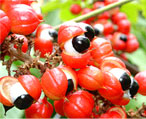



Guarana is the dried paste made from the led seeds of P. cupana or P. sorbilis, a fast-growingperennial shrub native to Brazil and other regions Amazon.1lt bears orange-yellow fruits that contain seeds each. The seeds are collected and dry? over fire. The kernels are ground to a paste with va and molded into cylindrical sticks, which are then d. Today, the most common forms of guarana lie syrups, extracts, and distillates used as flavorings a source of caffeine by the soft drink industry. In also is used as an ingredient in herbal weight preparations usually in combination with ma huang.
Guarana has played an important role in the I1ian Indians' society. It is often taken during peri? lfasting to improve tolerance of dietary restrictions. lain regions, the extract is believed to be an siac and to protect from malaria and dysentery.2,3 19th century, guarana became popular as a stimu?dnnk in France,1 and in 1880 was introduced as an drug in the US Pharmacopeia, where it remained until 1910.4 Natural diet aids, which rely on daily of guarana, have been advertised in the lay press. na is occasionally combined with glucomannan in I weight loss tablets. The advertisements indicate ingredients in guarana have the same chemical p as caffeine and cocaine but can be used for reduction without any of the side effects of these This is not entirely correct istems, leaves, and roots of guarana are used as a r.~lling drug in Central and South America.
Guarana is used by Brazilian Indi?a stimulating beverage used like tea or coffee; it is imes mixed with alcohol to prepare a more intoxi? beverage. In 1840, caffeine was identified as na's principal constituent, with a level ranging from to greater than 5% by dry weight.
comparison, coffee beans contain = 1 % to 2% caf?18 and dried tea leaves vary from 1 % to 4% caffeine Itent.5 The related alkaloids theophylline and theobro? have also been identified in the plant. Guarana is high in tannins (primarily catechutannic acid and hol), present in a concentration of 5% to 6% dry WQlght; these impart an astringent taste to the product. Guarana contains no cocaine.
The appetite suppressant effect is related to the caffeine content. The "zap of energy" that guarana tablets are reported to give is also due to caffeine. This stimulating effect is so widely recognized that guarana is sometimes called "Zoom."
Trace amounts of a saponin known as timbonine, related to compounds reported in timbo fish poisons used by Amazonian Indians, have been reported.
Guarana extracts have been shown to inhibit aggregation of rabbit and human platelets following either parenteral or oral administration, possibly due to inhibition of platelet thromboxane synthesis.
Some researchers claim that part of the revitalizing effects of guarana may be because of its antioxidant action?
Numerous investigational studies have shown the ability of the sympathetic stimulant ephedrine, when coupled with caffeine, to have a synergistic effect on increasing metabolic rates with subsequent increased energy ex?penditure (thermogenesis), and to have lipolytic effects.8 These effects have resulted in a statistically significant weight loss in animal and human trials when combined with diet.
In one animal study, behavioral effects in rats and mice subsequent to acute and chronic guarana administration were observed? In this study, groups of animals treated with guarana in doses of 2000 mg/kg showed no differ?ence when compared with control groups for the param?eters of motor activity, tremor, or salivation. Another study showed an increase in physical capacity when mice were subjected to a stressful situation, such as forced swim?ming, after 3 to 6 months of guarana treatment.
There are few human clinical trials concerning the safety and efficacy of guarana. In a small study, 3 groups of normal volunteers ranging from 20 to 35 years of age were given either placebo, 25 mg caffeine, or 1000 mg of guarana containing 2.1 % caffeine daily. After 4 days, no reproducible improvement in cognition was noted in any group using neuropsychological testing, assessment of sleep quality, and a State-Trait Anxiety Inventory.
Copyright © Krishna Herbal Company 2022. All Rights Reserved Powered By: Planet Ayurveda







